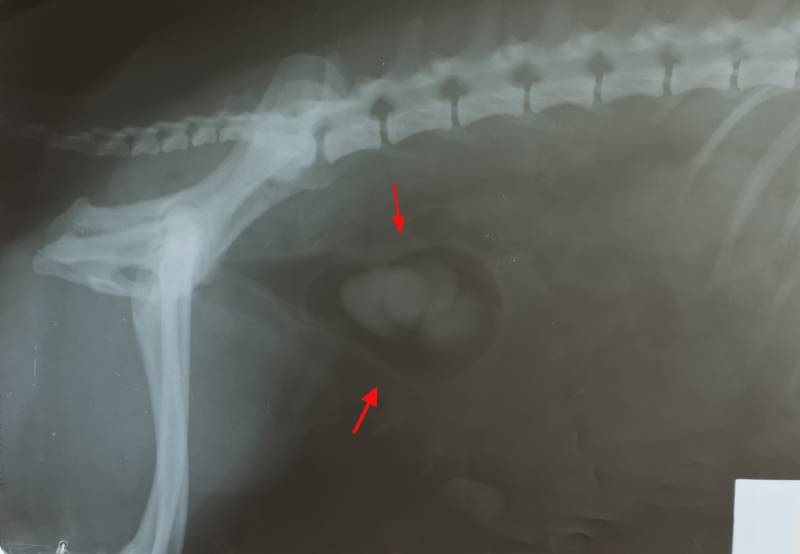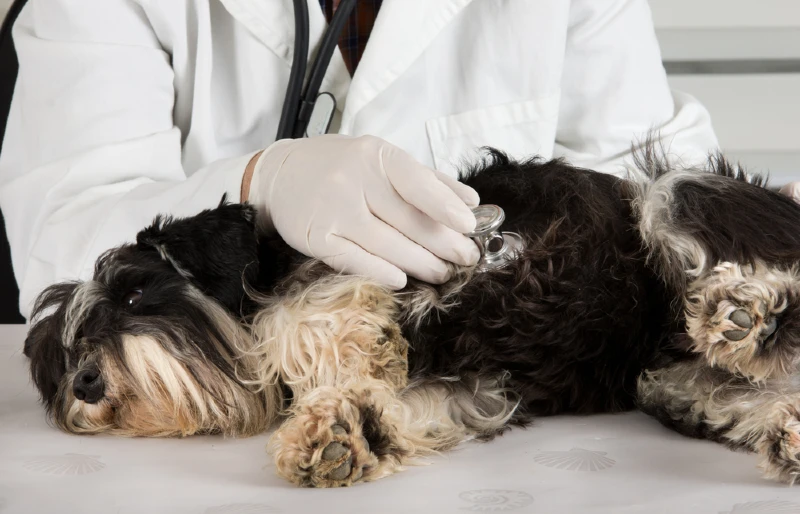Click to Skip Ahead
As the saying goes, good things come in small packages. And this is also true for our canine companions. On the other hand, despite their cuteness and amazing qualities, small dog breeds are prone to some diseases. Sadly, the spunky Miniature Schnauzer is one such breed. But don’t despair: with a good knowledge of these issues, responsible breeding, and regular check-ups by a veterinary team, you have every chance of spotting these issues and helping your Mini Schnauzer live their best life by your side.
So, let’s explore the common Miniature Schnauzer health problems, along with the causes, diagnosis, and treatment available. There are also tips for bringing home a healthy Schnauzer puppy.
The 7 Common Miniature Schnauzer Health Problems
1. Bladder Stones

Miniature Schnauzers are predisposed to form bladder stones, usually struvite1 or calcium oxalate stones.2, but others such as urate and calcium phosphate may also occur.
Uroliths (commonly called bladder stones) may form when mineral crystals in urine combine to form stones. These are classified depending on the type of mineral that they are composed of. Uroliths may develop or remain anywhere in the urinary tract, but most end up in the bladder or in the urethra, causing obstructions.
- Struvite stones: Magnesium ammonium phosphate (struvite) crystals can be present in a dog’s urine and cause no problems while the pH remains acidic (low) and the urine is not too concentrated. However, if the pH increases (becomes more alkaline), usually because of a urinary infection, the struvite crystals will no longer be able to dissolve and will form stones.
- Calcium oxalate stones: These types of stones form when calcium and oxalate ions combine. Miniature Schnauzers have a greater risk of forming such stones, but the exact mechanism is not fully understood.3 These can cause life-threatening obstructions of the urinary tract and often need to be removed with surgery since diet itself won’t dissolve them.
- Urinary accidents
- Increased frequency of urination (pollakiuria)
- Straining to urinate (dysuria)
- Blood in the urine (hematuria)
- Abdominal pain
Causes
A bladder infection—often caused by urease-producing bacteria like Staphylococcus spp.—can make dog urine too alkaline, causing struvite stones to form.4 Certain kidney diseases can also predispose some dogs to develop these types of bladder stones.
As for calcium oxalate stones, their exact cause is still unclear, though everything points to an underlying genetic predisposition that Miniature Schnauzers seem to have, unfortunately.
Diagnosis
Since most signs of bladder stones in dogs are consistent with other urinary diseases, the vet will normally use imaging tests (X-ray and/or ultrasound), along with blood and urinary tests to establish the diagnosis.
Treatment
The treatment for this condition mainly depends on the type of bladder stones and each dog’s individual situation.
- Surgical removal
- Non-surgical removal (by urohydropropulsion)
- Special diet to help dissolve stones
Important: If your dog is unable to urinate, stones may be blocking their urethra. This is a life-threatening situation, so you must take your dog to the nearest hospital or veterinary clinic right away.
2. Cataracts

Cataracts are a common eye disorder in older dogs, but they can affect younger dogs, too.5 Miniature Schnauzers are predisposed to cataracts that might be congenital (present at birth) or juvenile (from 6 months onwards).6 This condition is characterized by cloudiness of the lens of the eye.
Cataracts always need to be checked by a veterinary ophthalmologist, and surgery is the only successful treatment. In most cases, if the cataract is left untreated, it can lead to total vision loss.
Miniature Schnauzers are predisposed to inherited cataracts, but cataracts can also be caused by diabetes, trauma, inflammation, retinal problems, or related to age.
- Cloudy eyes
- Whitish appearance of the pupil
- Signs of sight loss (like bumping into furniture or barking at inanimate objects)
- Complications such as lens-induced uveitis, glaucoma, and lens luxation
Causes
Miniature Schnauzers are predisposed to inherited cataracts, but cataracts may also be associated with old age or develop secondary to diabetes, eye diseases, or trauma.
Diagnosis
Using a light, the veterinarian will check for opacities in the lens and will check your dog’s vision. If they suspect your Miniature Schnauzer has developed cataracts, a referral to a veterinary ophthalmologist is necessary to assess the type of cataract and speak about surgery, if necessary.
Treatment
Surgery is the only option for treating cataracts. The surgery involves pulverizing and vacuuming the inside of the lens and, in most cases, replacing the lens with an implant, which restores the dog’s vision.
3. Pancreatitis

Miniature Schnauzers are predisposed to pancreatitis, an inflammatory reaction of the pancreas, which can be acute or chronic. In severe cases, pancreatitis can cause collapse and shock, which can be fatal.
- Lethargy
- Loss of appetite
- Vomiting
- Diarrhea
- Abdominal pain
- Collapse and shock in severe cases
Causes
Miniature Schnauzers are predisposed to pancreatitis, which might be associated with hyperlipidemia as well. Currently, the genetic basis of this predisposition is unclear.
Diagnosis
Since many other diseases can cause the same signs, different blood tests, and imaging of the abdomen (usually by ultrasound) are required to diagnose pancreatitis in dogs. Ultrasound will also reveal potential complications.
Treatment
There is no specific treatment for pancreatitis, but fortunately, most dogs recover with proper symptomatic treatment.
Most dogs with this condition require hospitalization to provide necessary treatment to control nausea, pain, and possible complications. Some less severe cases might be treated at home, but adequate hydration and proper nutrition are vital for recovery, and this might not be possible with only home care.
4. Atopic Dermatitis
Atopic dermatitis, simply called “atopy,” is a common condition in Miniature Schnauzers. Atopy involves skin allergies due to airborne seasonal or non-seasonal allergens (dust, pollens, molds) in the environment. Typical body parts affected are paws, skin on abdomen, skin folds, and ears.
- Itching
- Redness
- Hair loss
- Pustules
- Ear malodor
- Ear discharge
Causes
Atopy is caused by an exaggerated response of a dog’s immune system against airborne particles (allergens), which, in non-atopic dogs, do not cause any reactions. The common allergens that can cause atopy in dogs include different pollens, molds, house dust mites, house dust, and various other proteins that can come from insects and natural fibers.
Diagnosis
The veterinarian will perform a full physical exam, take a thorough history, and perform some blood tests to try to identify the allergen (or allergens) causing the skin reaction.
Treatment
While allergies can’t be cured, your veterinarian will provide you with a management plan to make your Miniature Schnauzer as comfortable as possible. Success usually lies in using a combination of several treatments. Some of the possible treatments include:
- Antihistamines
- Medicated shampoos or foams
- Medicated creams
- Food supplements
- Immunotherapy
- Immunosuppressive medication
- Strict parasite treatment
5. Hyperlipidemia

Primary idiopathic hyperlipidemia causes an abnormal increase in lipids (fats) in the blood. These can be triglycerides and sometimes cholesterol. Miniature Schnauzers are commonly affected and the reason behind this problem is not yet defined. Researchers are trying to identify the gene mutation that can be involved in this problem.
- Lipid deposits in eyes
- Loss of appetite
- Vomiting
- Diarrhea
- Abdominal pain
- Pancreatitis
- Seizures
Causes
- Genetics of Miniature Schnauzers
- Other causes are possible: obesity, endocrine disorders, and certain medications.
Diagnosis
The veterinarian will perform a thorough physical examination of the Miniature Schnauzer, followed by blood and urine tests.
Treatment
Treatment consists of changing the dog’s diet (switching to a low-fat diet) and taking supplements and/or medication to control the lipid levels.
6. Liver Shunts

A liver shunt in Miniature Schnauzers is a congenital (present at birth) condition that describes abnormal blood flow that bypasses the liver, resulting in the inability of this organ to perform its essential functions properly. Miniature Schnauzers and other dog breeds can have this liver abnormality.
- Poor growth
- Poor appetite
- Lethargy
- Diarrhea (might be bloody)
- Vomiting (might be bloody)
- Increased thirst and urination
- Abnormal behavior after eating
- Circling, head pressing
- Seizures
Causes
Miniature Schnauzers are predisposed to congenital liver shunts (present at birth). Acquired liver shunts develop later in life and they occur as a consequence of liver or vascular disease in any dog breed. It’s strongly recommended to avoid breeding affected dogs.
Diagnosis
Diagnosis of a liver shunt typically involves a combination of physical examination, routine and specialized blood tests, and imaging techniques (such as ultrasound or CT scan).
Treatment
Treatment options vary depending on the severity and location of the shunt (if it’s located within or outside the liver). They may include dietary management, medications to manage side effects, and surgical intervention to redirect blood flow or correct the shunt.
7. Myotonia
Myotonia congenita is a hereditary musculoskeletal condition that Miniature Schnauzers can suffer from. It’s characterized by the prolonged contraction or stiffness of muscles after they are stimulated. It is a painful condition that can affect various muscle groups in the body, including the legs, jaw, and neck. A genetic test is available and should be performed in parents since some dogs might be carriers with no clinical signs.
- Muscle stiffness
- Difficulty breathing
- Difficulty rising or moving
- Difficulty swallowing
- Regurgitation
Causes
Myotonia is a genetic condition.
Diagnosis
The veterinarian will conduct a physical examination, evaluate the dog’s medical history, and perform additional tests, such as electromyography, to assess muscle activity. A DNA test can also tell if your dog or your puppy’s parents carry the gene for myotonia.
Treatment
There is currently no cure for myotonia, but management strategies can be employed to help affected dogs live a more comfortable life. These may include medications and exercise restrictions.
Tips for Bringing Home a Healthy Miniature Schnauzer Puppy
Reading about all these potential diseases for Miniature Schnauzers can be scary, but don’t fret; if you haven’t brought your pup home yet, here are a few tips to help you ensure that you bring home a healthy dog:
- Look for the hidden gem. There are many responsible and ethical breeders out there, but you need to do your homework to find them. Search reputable websites like the American Miniature Schnauzer Club for a list of trusted breeders.
- Visit the facility or the breeder’s house. This first-hand experience will give you insight into the cleanliness, socialization, and general care provided to the puppies. You may also get the chance to meet the puppy’s parents.
- Make sure all genetic testing has been done. This is one of the best ways to avoid ending up with a Miniature Schnauzer with a breed-specific genetic disorder.
- Consider adopting an older Miniature Schnauzer. Every dog deserves a chance, and adopting a Miniature Schnauzer from a shelter can be a very rewarding experience. Get as much information as possible about your new family member from the shelter and, if in doubt, visit your veterinarian as soon as you bring them home.
- Work closely with your veterinarian throughout all stages of your beloved dog’s life. This way, diseases can be diagnosed and treated in time.
Conclusion
We know how heartbreaking it is to see a sick dog, and when it’s yours, the pain can be unbearable. That’s why it’s essential to learn about common diseases for the dog breed that has captured your heart—in this case, the fiery and charismatic Miniature Schnauzer.
This way, if you decide to get your pup from a breeder, you can choose a trusted breeder who can answer any questions that you may have and recognize the early signs of illness. By working closely with your veterinarian and providing all the necessary care for your Mini Schnauzer, you will give them every chance of spending many happy and healthy years by your side.
Featured Image Credit: otsphoto, Shutterstock













